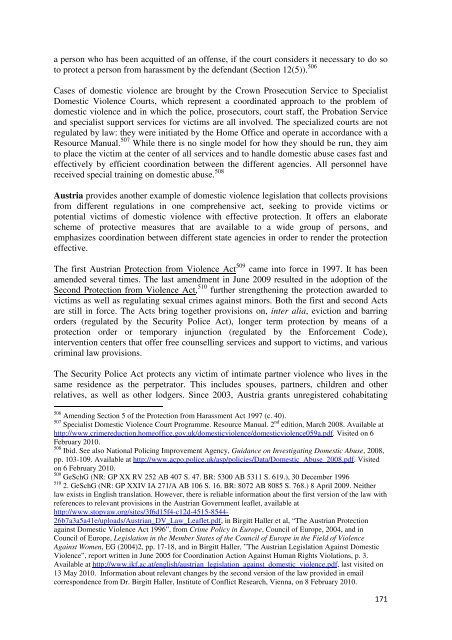Johanna Westeson - The ICHRP
Johanna Westeson - The ICHRP
Johanna Westeson - The ICHRP
Create successful ePaper yourself
Turn your PDF publications into a flip-book with our unique Google optimized e-Paper software.
a person who has been acquitted of an offense, if the court considers it necessary to do so<br />
to protect a person from harassment by the defendant (Section 12(5)). 506<br />
Cases of domestic violence are brought by the Crown Prosecution Service to Specialist<br />
Domestic Violence Courts, which represent a coordinated approach to the problem of<br />
domestic violence and in which the police, prosecutors, court staff, the Probation Service<br />
and specialist support services for victims are all involved. <strong>The</strong> specialized courts are not<br />
regulated by law: they were initiated by the Home Office and operate in accordance with a<br />
Resource Manual. 507 While there is no single model for how they should be run, they aim<br />
to place the victim at the center of all services and to handle domestic abuse cases fast and<br />
effectively by efficient coordination between the different agencies. All personnel have<br />
received special training on domestic abuse. 508<br />
Austria provides another example of domestic violence legislation that collects provisions<br />
from different regulations in one comprehensive act, seeking to provide victims or<br />
potential victims of domestic violence with effective protection. It offers an elaborate<br />
scheme of protective measures that are available to a wide group of persons, and<br />
emphasizes coordination between different state agencies in order to render the protection<br />
effective.<br />
<strong>The</strong> first Austrian Protection from Violence Act 509 came into force in 1997. It has been<br />
amended several times. <strong>The</strong> last amendment in June 2009 resulted in the adoption of the<br />
Second Protection from Violence Act, 510 further strengthening the protection awarded to<br />
victims as well as regulating sexual crimes against minors. Both the first and second Acts<br />
are still in force. <strong>The</strong> Acts bring together provisions on, inter alia, eviction and barring<br />
orders (regulated by the Security Police Act), longer term protection by means of a<br />
protection order or temporary injunction (regulated by the Enforcement Code),<br />
intervention centers that offer free counselling services and support to victims, and various<br />
criminal law provisions.<br />
<strong>The</strong> Security Police Act protects any victim of intimate partner violence who lives in the<br />
same residence as the perpetrator. This includes spouses, partners, children and other<br />
relatives, as well as other lodgers. Since 2003, Austria grants unregistered cohabitating<br />
506 Amending Section 5 of the Protection from Harassment Act 1997 (c. 40).<br />
507 Specialist Domestic Violence Court Programme. Resource Manual. 2 nd edition, March 2008. Available at<br />
http://www.crimereduction.homeoffice.gov.uk/domesticviolence/domesticviolence059a.pdf. Visited on 6<br />
February 2010.<br />
508 Ibid. See also National Policing Improvement Agency, Guidance on Investigating Domestic Abuse, 2008,<br />
pp. 103-109. Available at http://www.acpo.police.uk/asp/policies/Data/Domestic_Abuse_2008.pdf. Visited<br />
on 6 February 2010.<br />
509 GeSchG (NR: GP XX RV 252 AB 407 S. 47. BR: 5300 AB 5311 S. 619.), 30 December 1996<br />
510 2. GeSchG (NR: GP XXIV IA 271/A AB 106 S. 16. BR: 8072 AB 8085 S. 768.) 8 April 2009. Neither<br />
law exists in English translation. However, there is reliable information about the first version of the law with<br />
references to relevant provisions in the Austrian Government leaflet, available at<br />
http://www.stopvaw.org/sites/3f6d15f4-c12d-4515-8544-<br />
26b7a3a5a41e/uploads/Austrian_DV_Law_Leaflet.pdf, in Birgitt Haller et al, “<strong>The</strong> Austrian Protection<br />
against Domestic Violence Act 1996”, from Crime Policy in Europe, Council of Europe, 2004, and in<br />
Council of Europe, Legislation in the Member States of the Council of Europe in the Field of Violence<br />
Against Women, EG (2004)2, pp. 17-18, and in Birgitt Haller, ”<strong>The</strong> Austrian Legislation Against Domestic<br />
Violence”, report written in June 2005 for Coordination Action Against Human Rights Violations, p. 3.<br />
Available at http://www.ikf.ac.at/english/austrian_legislation_against_domestic_violence.pdf, last visited on<br />
13 May 2010. Information about relevant changes by the second version of the law provided in email<br />
correspondence from Dr. Birgitt Haller, Institute of Conflict Research, Vienna, on 8 February 2010.<br />
171
















